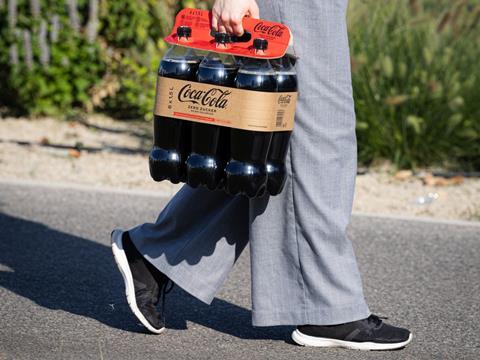
Coca-Cola HBC is piloting a cardboard and paper alternative to plastic shrink film for 1.5-litre multipacks of Coca-Cola, Fanta, and Sprite sold in Austria – a move anticipating a 200-tonne reduction in plastic every year.
LitePac Top is described as a 100% recyclable cardboard and paper carrier and wrap. It is designed to help retailers stack the multipacks for sale, and for consumers to carry and recycle the packaging with ease.
Said to support the weight of a six-pack of 1.5-litre bottles, or approximately 9kg in weight, the solution hopes to phase out the use of plastic shrink wrap in large, heavy multipack bottles. Its rollout in Austria anticipates a significant reduction in both plastic consumption and energy costs generated in production.
Furthermore, the trial hopes to bring Coca-Cola HBC closer to its NetZeroBy40 target, in which it seeks to achieve net zero emissions across its value chain by 2040.
“This is the first-ever packaging solution of its kind for 1.5 litre multipacks of Coca-Cola, Fanta and Sprite,” says Marcel Martin, chief Corporate Affairs and Sustainability officer at Coca-Cola HBC. “It’s the result of our entrepreneurial mindset, an absolute belief in collaborating with trusted partners and our focus on reaching net zero emissions by 2040.”
LitePac Top was developed over three years in an international partnership between Coca-Cola HBC, Krones, DS Smith, and Mondi – resulting in both the solution itself and the necessary production equipment to produce it. The packaging has been tested for quality, consumer appeal, and ease of use before its launch, the companies explain.
“We know that to carve new paths and make real progress towards Net Zero, we must work with companies that share our sustainability goals,” adds Ivo Bjelis, chief supply chain officer at Coca-Cola HBC. “The collaboration and determination to find the right solution from our international partners was outstanding as we all contribute to building a circular economy.
“This solution offers a real opportunity to take plastic out from secondary packaging, so we’ll assess how well it performs and if people want to buy it.”
Back in 2019, Smurfit Kappa launched a range of recyclable, renewable, and biodegradable packaging solutions for can and bottle multipacks in the hopes of cutting down on single-use plastic alternatives. This includes the TopClip, which reportedly offers a 30% reduction in carbon footprint.
Beer brewer Royal Grolsch then adopted TopClip as an alternative to plastic shrink wrap for its cans, followed by Budweiser Budvar UK.
Last year, Graphic Packaging’s EnviroClip – reportedly made from a single ply of paperboard – was rolled out as a similar alternative to shrink films and plastic rings for cans, as well as a solution to complement its existing KeelClip range.
DS Smith and Krones also unveiled ECO Carrier, a fibre-based alternative to shrink wrap designed to package PET multipack bottles.
If you liked this article, you might also enjoy:
The Lidl approach to packaging sustainability
How did Brazil achieve its 100% aluminium can recycling rate – and can it be replicated in the EU?
Experts have their say on the EU’s Packaging and Packaging Waste Directive revisions
A deep dive into the most important packaging sustainability trends and solutions












No comments yet